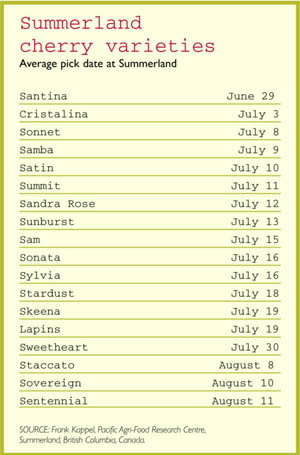 New, late-maturing cherry varieties developed in British Columbia, Canada, have helped keep the province’s cherry growers in business.
New, late-maturing cherry varieties developed in British Columbia, Canada, have helped keep the province’s cherry growers in business.
“At one stage, the cherry industry was dwindling away until these late varieties were introduced,” recalled Dr. Frank Kappel, cherry breeder at the Pacific Agri-Food Research Centre in Summerland.
The Summerland program continues to develop new late varieties that allow Canadian growers to be in the market after Washington’s peak production, when prices tend to strengthen. While the province’s apple acreage is being converted to vineyards, its cherry industry has been stable. There are about 4,500 acres of cherries, which produced about a million 20-pound packs last season.
The Summerland research center has been breeding cherries since 1939 and had the initial goal of breeding a better Bing—a Bing with less splitting, Kappel said.
Stella, the first self-fertile variety from the program, was released in 1968, and most of the self-fertile cherries released around the world since then have Stella in their background.
Kappel said the program is no longer focused on producing a better version of any current variety. The objective is to produce new, large, firm cherries that are not prone to cracking and have stems that stay green. They should be suited to growing conditions in British Columbia and cover a range of maturity dates.
Now, some B.C. grower-packers are showing interest in early varieties, reasoning that customers who buy late cherries might want fruit from the same source earlier in the season, even if they don’t pay a premium. A range of maturity dates also helps attract and keep a labor force. Summerland’s earliest cherry is Santina, which ripens in late June. Next comes Cristalina, which matures in early July.
Kappel is also looking for a new variety that ripens during the ten-day window between Lapins and Sweetheart, around the third week of July.
Average fruit weight of new releases must be at least ten grams. Also, for the past three years, the evaluation has included stem-removal force to assess how loose the stems are. Kappel is looking for cherries that stay on the tree.
Powdery mildew
In his quest to produce varieties with resistance to powdery mildew, he has crossed the resistant Hedelfingen, which is not self-fertile, with self-fertile parents, such as Sweetheart, Lapins, Staccato, Skeena, and Sentennial.
He’s also crossed Sandra Rose, a good-tasting cherry that’s too soft, with Samba, an early-season firm cherry, hoping to combine the best traits of both. “Sandra Rose is my favorite cherry to eat, but it’s not firm enough,” Kappel commented.
Self-fertile
The program has a couple of non-self-fertile advanced selections that it will go ahead and name, but in the future, all advanced selections will have to be self fertile, Kappel said. One advanced selection, SPC (Summerland Pico Cherry) 136, will be released as soon as there is a supply of virus-free propagation material for growers. It is a large, firm, nice-tasting, and attractive cherry that ripens just after Bing.
Kappel uses a genetic marker to identify the self-fertility trait in young seedlings in the greenhouse so he can eliminate those that are not self-fertile before they’re planted out.
Self-fertility is a double-edged sword, he noted. On the positive side, production tends to be more consistent, particularly in poor pollination years. Some growers won’t plant varieties that are not self fertile. The down side is that when conditions are good for pollination and fruit set, the trees can overcrop.
“You can have years when the cherries are roped on,” Kappel said. “But our growers are willing to deal with too many fruit rather than not enough. If you tell your buyer ‘I don’t have many cherries this year,’ they will not come back next year.”
Lapins
The B.C. cherry industry has done well with Lapins, which was released in 1984 and is the most widely planted variety in the province. It accounted for more than 25 percent of the new plantings in 2007. It has been less popular in Washington, where a segment of the industry has tried it and discounted it, Kappel said.
“It probably shouldn’t have been grown in the Columbia Basin. I don’t think the cherry can take 100°F weather. If Bing was a week later, I don’t think it would do well in that area.”
However, Lapins does seem suited to Washington’s cooler areas, such as Oroville, he said.
Sovereign and Sentennial are the two latest-maturing varieties from the program, maturing around August 10 or 11 at Summerland, and as late as September in the northern Okanagan Valley. They were released in 2006. Sovereign is a low-cropping variety with heart-shaped fruit and a long stem. Sentennial is a heavy cropper and looks similar to Staccato. It is extremely firm.
B.C. grower David Geen said he’s heard some people say it is too firm. “I would rather hear that than it’s too soft,” he said. “Too firm is a comment. Too soft is a claim.”
Kappel said he’s not looking for the perfect cherry because it doesn’t exist. He’s unlikely to find a cherry that ripens in the Burlat season, measures an inch in diameter, and is as hard as a rock.
“It’s all incremental—a little improvement here, a little bit firmer or a little bit later,” he said.
“I really think it’s going to be harder to introduce new cherry varieties that are that much better, because it will be just incremental.”

Leave A Comment